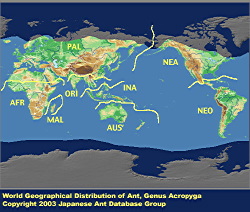
|
genus
|
Acropyga
|
 |
Japanese Name
|
Mitsuba-ari-zoku
|
Original Reference
|
|
Roger, J. (1862) Einige neue exotische Ameisen-Gattungen und Arten. Berliner Entomologische Zeitschrift 6: 233-254.
|
Synonym
|
|
Rhizomyrma Forel, 1893 (?r?1/4?C1929)
|
Description
|
|
Small ants: total length of workers less than 4 mm. Body color yellow to yellowish brown. Antennae 7- to 11-segmented (10- or 11-segmented in Japanese species). Eyes smaller than width of antennal scape, or absent. Ocelli lacking. Palpal formula 5:3 or less. Mesosoma compact, relatively very short; metanotal groove shallow; propodeum short. Propodeal spiracles large and oval. Petiole scale-like, relatively thin and low. Gaster disproportionately large.
|
|

|
Remarks
|
|
Acropyga engages in trophobiotic associations with myrmecophile mealy bugs (Homoptera) of the genera Eumyrmococcus, Xenococcus and Neochavesia. Honeydew provided by these insects is a major food source for the ants, which seldom forage above-ground. The mealy bugs live within the subterranean ant nests, where they are protected by the ants. They feed by sucking sap from the rootlets of plants accessible there. In order to maintain this ant/homopteran symbiosis in newly-founded colonies, reproductive females in some, perhaps all, Acropyga species carry gravid mealy bug females in their jaws during their mating flights. Acropyga is distributed worldwide in warm-temperate and tropical regions. There are about 60 described species. The genus is sometimes divided into four subgenera, Acropyga, Atopodon, Rhizomyrma, and Malacomyrma. Subgenus Acropyga is characterized by 11-segmented antennae and mandibles each with 5 triangular teeth. Subgenus Atopodon also has 11-segmented antennae and 5-toothed mandibles, but the basal tooth is truncated. Rhizomyrma is characterized by 8- to 11-segmented antennae and 3- or 4-toothed mandibles. Malacomyrma has 11-segmented antennae in which the terminal segment is remarkably long. Some taxonomists do not recognize these subgenera, the status of which deserves further study. Four species belonging either to Rhizomyrma or Atopodon are known from Japan. They are distributed in southern Honshu and southwards. The Japanese species and their symbiont mealy bugs were briefly reviewed by Terayama (1988), and Williams & Terayama (2000).
|
References
|
|
- Einige neue exotische Ameisen-Gattungen und Arten. Berliner Entomologische Zeitschrift 6: 233-254.
- Terayama, M. (1988). Taxonomy and ecology of myrmecophilous mealybug genus Eumyrmococcus. Rostria, (39), 643-648.
- Williams, D. J. & Terayama, M. (2000). A new species of the mealybug genus Eumyrmococcus Silvestri (Hemiptera: Pseudococcidae, Rhizoecinae) associated with the ant Acropyga (Rhizomyrma) kinomurai Terayama et Hashimoto (Hymenoptera: Formicidae) in the Ryukyu Islands, Japan. Ent. Sci. 3(2): 373-376.
- Teranishi, C. (1929a. ). Japanese ants, their behavior and distribution (I). . Zool. Mag. Tokyo, 41, 239-251. .
|
Editor
|
|
Original text by Mamoru Terayama and Masao Kubota. English translation by Mamoru Terayama, edited by Robert W. Taylor.
|
|